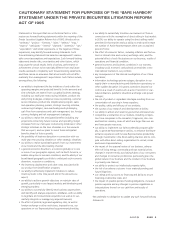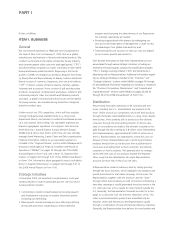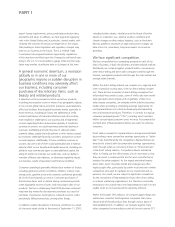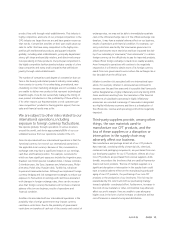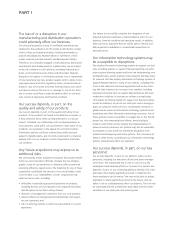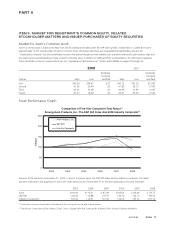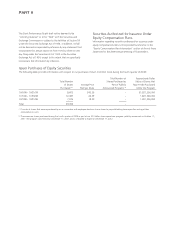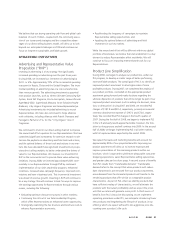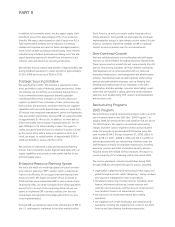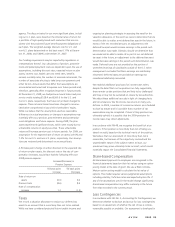Avon 2008 Annual Report Download - page 21
Download and view the complete annual report
Please find page 21 of the 2008 Avon annual report below. You can navigate through the pages in the report by either clicking on the pages listed below, or by using the keyword search tool below to find specific information within the annual report.Our ability to anticipate and respond to
market trends and changes in consumer
preferences could affect our financial
results.
Our continued success depends on our ability to anticipate,
gauge and react in a timely and effective manner to changes in
consumer spending patterns and preferences for beauty and
related products. We must continually work to develop, produce
and market new products, maintain and enhance the recog-
nition of our brands, achieve a favorable mix of products, and
refine our approach as to how and where we market and sell
our products. While we devote considerable effort and resources
to shape, analyze and respond to consumer preferences, con-
sumer spending patterns and preferences cannot be predicted
with certainty and can change rapidly. If we are unable to antici-
pate and respond to trends in the market for beauty and related
products and changing consumer demands, our financial results
will suffer. This risk may be exacerbated by our product line
simplification (“PLS”) program, which will lead to significant
changes to our product offerings.
Furthermore, material shifts or decreases in market demand for
our products, including as a result of changes in consumer
spending patterns and preferences, could result in us carrying
inventory that cannot be sold at anticipated prices or increased
product returns by our Representatives. Failure to maintain
proper inventory levels or increased product returns by our
Representatives could result in a material adverse effect on our
business, results of operations and financial condition.
If we are unable to protect our intellectual
property rights, specifically patents and
trademarks, our ability to compete could
be negatively impacted.
The market for our products depends to a significant extent
upon the value associated with our patents and trademarks. We
own the material patents and trademarks used in connection
with the marketing and distribution of our major products both
in the U.S. and in other countries where such products are
principally sold. Although most of our material intellectual prop-
erty is registered in the U.S. and in certain foreign countries in
which we operate, there can be no assurance with respect to
the rights associated with such intellectual property in those
countries. In addition, the laws of certain foreign countries, in-
cluding many emerging markets, such as China, may not protect
our intellectual property rights to the same extent as the laws of
the U.S. The costs required to protect our patents and trade-
marks may be substantial.
We are involved, and may become involved
in the future, in legal proceedings that, if
adversely adjudicated or settled, could
adversely affect our financial results.
We are and may, in the future, become party to litigation, in-
cluding, for example, claims relating to our customer service or
advertisings, or alleging violation of the federal securities or
ERISA laws and/or state law. In general, litigation claims can be
expensive and time consuming to bring or defend against and
could result in settlements or damages that could significantly
affect financial results. We are currently vigorously contesting
certain of these litigation claims. However, it is not possible to
predict the final resolution of the litigation to which we currently
are or may in the future become party to, and the impact of
certain of these matters on our business, results of operations
and financial condition could be material.
Significant changes in pension fund
investment performance, assumptions
relating to pension costs or required legal
changes in pension funding rules may have
a material effect on the valuation of
pension obligations, the funded status of
pension plans and our pension cost.
Our funding policy for pension plans is to accumulate plan assets
that, over the long run, will approximate the present value of
projected benefit obligations. Our pension cost is materially
affected by the discount rate used to measure pension obliga-
tions, the level of plan assets available to fund those obligations
at the measurement date and the expected long-term rate of
return on plan assets. Significant changes in investment per-
formance or a change in the portfolio mix of invested assets can
result in corresponding increases and decreases in the valuation
of plan assets, particularly equity securities, or in a change of the
expected rate of return on plan assets. A change in the discount
rate would result in a significant increase or decrease in the
valuation of pension obligations, affecting the reported funded
status of our pension plans as well as the net periodic pension
cost in the following fiscal years. Similarly, changes in the ex-
pected return on plan assets can result in significant changes
in the net periodic pension cost of the following fiscal years.
Finally, recent pension funding requirements under the Pension
Protection Act of 2006 may result in a significant increase or
decrease in the valuation of pension obligations affecting the
reported funded status of our pension plans.
A V O N 2008 15


